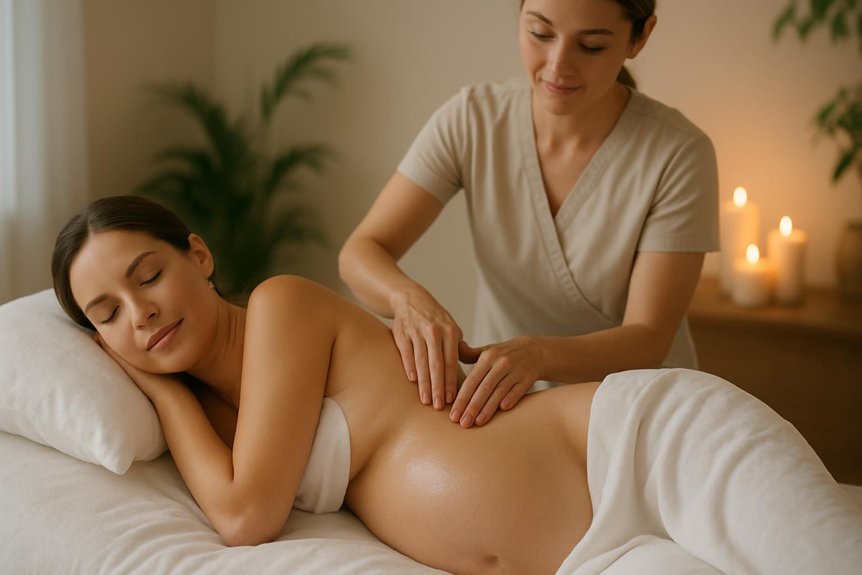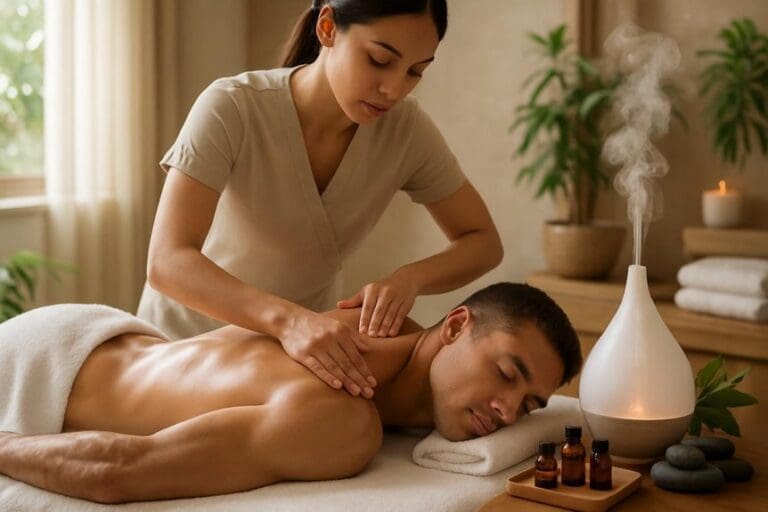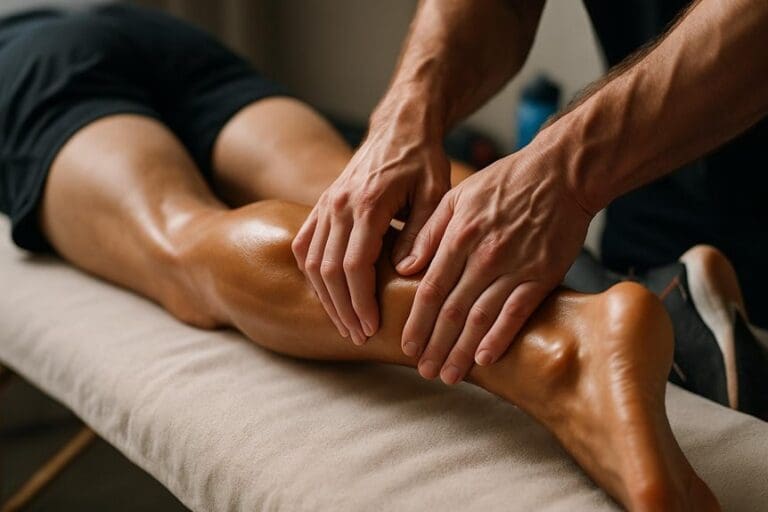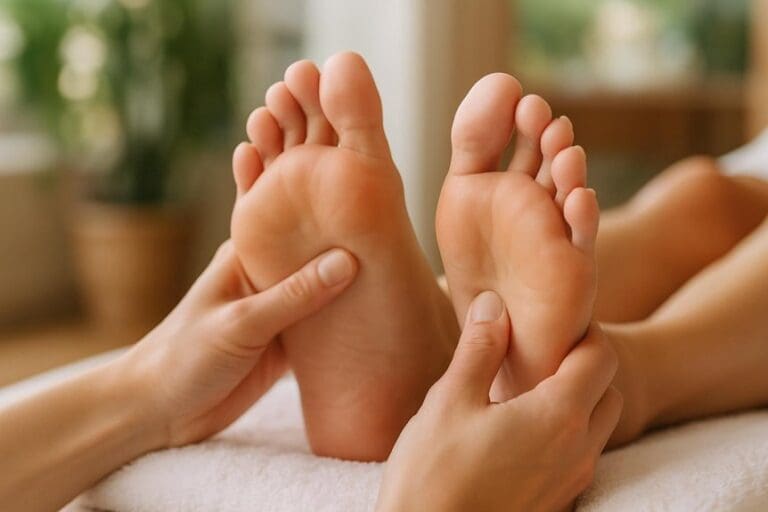Massage is generally considered safe during pregnancy if performed by a properly trained therapist using appropriate techniques, particularly after the first trimester. Careful screening and adaptation of positioning and pressure are essential to guarantee maternal and fetal wellbeing. Certain medical conditions or high-risk pregnancies are contraindications, so consultation with a healthcare provider is advised. Evidence supports benefits such as reduced physical discomfort and stress. Further information explains when massage should be avoided and how safety and comfort are prioritized.
Understanding the Safety of Massage During Pregnancy
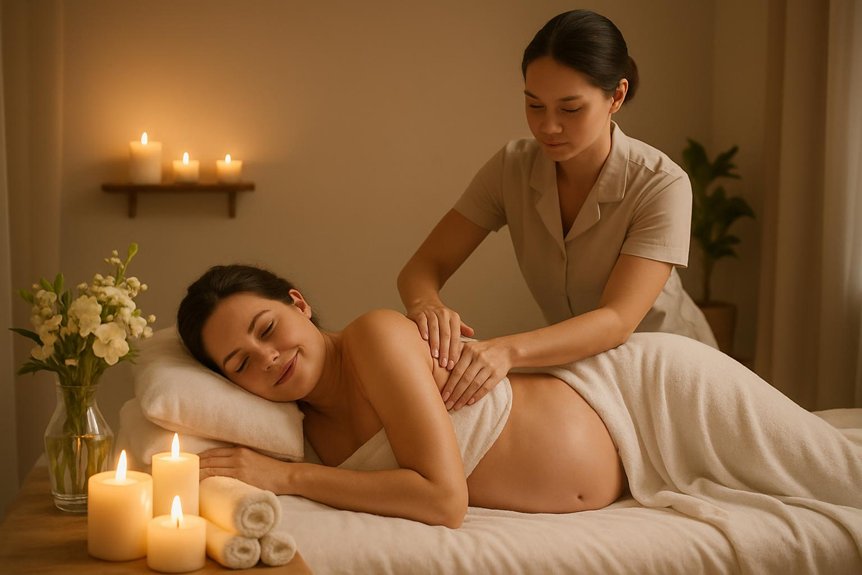
When considering the safety of massage during pregnancy, it is essential to evaluate both maternal and fetal well-being in light of current clinical guidelines and evidence.
Clinical research and professional consensus indicate that, when performed by trained therapists, massage can be safe for most pregnant individuals, particularly after the first trimester.
At Spa & Massage, therapists adhere to evidence-based protocols, carefully modifying techniques and positioning to support comfort and reduce risk.
Contraindications, such as high-risk pregnancies or certain medical conditions, are always screened for during client consultations.
Gentle, nurturing touch—avoiding deep pressure on vulnerable areas—remains central.
Each session is personalised, with special attention to communication and ongoing assessment, ensuring safety and peace of mind for expectant mothers seeking support and connection.
Many find value in complementary approaches such as the healing power of reflexology for additional relaxation and wellness during pregnancy.
Key Benefits of Pregnancy Massage
This massage is associated with significant relief of musculoskeletal discomfort, particularly in the lower back, hips, and legs, which are common during pregnancy.
Studies suggest that regular massage may also promote emotional wellbeing by reducing stress and anxiety levels.
At Spa & Massage, therapists apply evidence-based techniques that prioritise both physical comfort and psychological support for expectant mothers.
Eases Aches and Pains
As the body undergoes significant physiological changes during gestation, musculoskeletal discomfort is a common experience for many expecting mothers. The shifting centre of gravity, ligament laxity, and increased body weight often contribute to lower back pain, pelvic discomfort, and tension in the shoulders and neck.
Evidence supports that gentle, tailored prenatal massage can help alleviate these aches by promoting circulation, reducing inflammation, and relaxing tense muscle groups. At Spa & Massage, therapists are trained to use safe, supportive positioning and adapt pressure specifically for pregnant clients.
Techniques such as gentle effleurage and targeted kneading are employed to ease localized discomfort while ensuring comfort and safety. Many clients report a noticeable reduction in pain and improved mobility following a session, supporting overall physical wellbeing during pregnancy.
Supports Emotional Wellbeing
Beyond physical relief, the emotional landscape of expectant mothers also warrants careful consideration. Pregnancy often brings heightened anxiety, mood fluctuations, and disrupted sleep, all of which may impact emotional wellbeing.
Evidence indicates that professional prenatal massage can help reduce stress hormones and promote the release of endorphins—natural mood enhancers. At Spa & Massage, therapists are trained to create a calming environment that prioritises emotional comfort, using gentle techniques and soothing oils appropriate for pregnancy.
Many clients report feeling calmer, more balanced, and better able to cope with the emotional demands of pregnancy following regular sessions.
When to Avoid Massage While Pregnant
When is it necessary to postpone or forgo massage during pregnancy? Caution is warranted if a client is experiencing complications such as preeclampsia, deep vein thrombosis, severe swelling, heavy vaginal bleeding, or preterm labor symptoms.
Any unexplained pain, fever, or sudden changes in pregnancy status also require prompt medical evaluation before considering massage.
At Spa & Massage, therapists are trained to conduct a detailed consultation to identify potential contraindications.
In the first trimester, some individuals prefer to delay massage due to higher miscarriage risk, though evidence remains inconclusive.
Medical advice is indispensable if there is a history of high-risk pregnancy or current medical concerns.
Ultimately, safety and comfort guide every decision, ensuring that care is both nurturing and medically appropriate throughout pregnancy.
Techniques and Oils Used in Maternity Massage at Spa & Massage
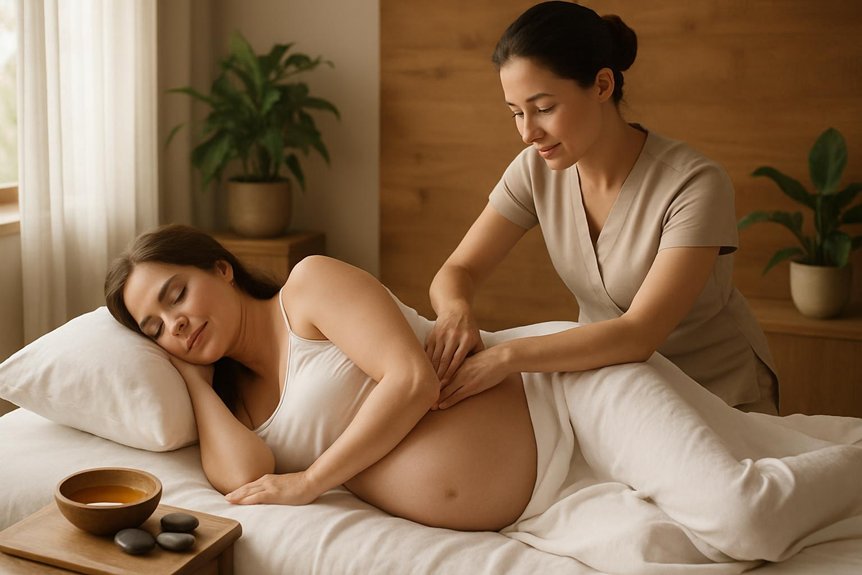
How are this massage techniques and oils selected to prioritise both maternal and fetal well-being?
At Spa & Massage, therapists employ gentle, targeted techniques designed to relieve tension without placing undue pressure on sensitive areas. Lateral positioning with supportive cushions is standard, helping to guarantee comfort and ideal circulation throughout the session.
Only light to moderate strokes are applied, carefully avoiding deep tissue manipulation that might be unsuitable during pregnancy.
For oils, Spa & Massage exclusively uses unscented or mild, pregnancy-safe oils—such as pure grapeseed or sweet almond—avoiding essential oils known to pose risks. Selection is guided by evidence-based protocols and client-specific sensitivities, minimising the chance of allergic reactions.
Every product and technique is chosen to foster relaxation, safety, and a sense of nurturing connection.
How Our Therapists Ensure a Safe and Comfortable Experience
At Spa & Massage, therapists are trained in specialised massage techniques that prioritise maternal safety and comfort.
Each session incorporates tailored support and positioning, such as side-lying or semi-reclined arrangements, to minimise pressure on sensitive areas and optimise relaxation.
This evidence-based approach helps reduce the risk of discomfort and supports the well-being of both mother and baby.
Specialised Prenatal Massage Techniques
A carefully structured approach underpins the prenatal massage techniques practised by the therapists at Spa & Massage. Each session is guided by an evidence-based understanding of maternal anatomy and physiology, with an emphasis on safety and therapeutic benefit.
Therapists employ gentle, rhythmic strokes and light to moderate pressure, deliberately avoiding deep tissue manipulation and trigger points known to be contraindicated during pregnancy. Attention is given to areas where expectant mothers most often experience tension, such as the lower back, hips, and shoulders, always ensuring movements are soothing and supportive.
The choice of massage oils at Spa & Massage is equally considered, favouring unscented, hypoallergenic formulations suitable for sensitive skin. Every element of technique and touch is designed to instil comfort, security, and relaxation.
Tailored Support and Positioning
Recognising that proper positioning is essential for the wellbeing of both mother and baby, Spa & Massage therapists employ specialised support techniques throughout each prenatal massage session.
Therapists utilise supportive cushions and bolsters, designed to relieve pressure from the lower back and hips, and to guarantee ideal comfort in side-lying or semi-reclined positions.
This careful approach helps maintain healthy circulation, reduces the risk of strain, and respects the physiological changes occurring during pregnancy.
Every adjustment is made with safety in mind, taking into account gestational age and individual client needs.
Therapists maintain open communication, encouraging expectant mothers to express any discomfort.
This evidence-based, personalised care fosters a sense of security and nurtures both physical and emotional wellbeing, aligning with Spa & Massage’s commitment to client-centred practice.
Aftercare Tips for Expectant Mothers Post-Massage
Following a prenatal massage, appropriate aftercare is essential to maximise the benefits and guarantee the well-being of both mother and baby. Spa & Massage therapists advise clients to hydrate well, as increased circulation and lymphatic drainage can lead to mild dehydration.
Resting for at least 15–30 minutes post-session allows the body to integrate the treatment’s effects. Gentle stretching, as recommended by the therapist, may support ongoing relief of muscular tension.
Monitoring for unusual symptoms—such as dizziness, persistent discomfort, or swelling—is imperative; any concerns should prompt consultation with a healthcare provider.
At Spa & Massage, fragrance-free oils are used to minimise skin sensitivity, and clients are encouraged to avoid strenuous activities for the remainder of the day, fostering relaxation and excellent therapeutic outcomes.
Conclusion
In conclusion, massage during pregnancy, when conducted by qualified professionals following established guidelines, can offer significant physical and emotional relief. As Spa & Massage demonstrates, careful attention to technique and individual circumstances ensures safety for both mother and baby. Expectant mothers should remember that “an ounce of prevention is worth a pound of cure”—consulting healthcare providers and choosing reputable therapists is essential for maximising the benefits and minimising potential risks of prenatal massage therapy.
